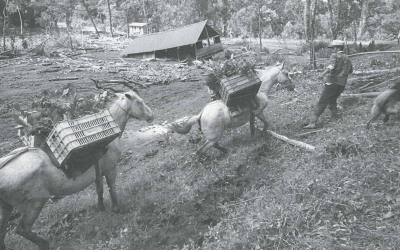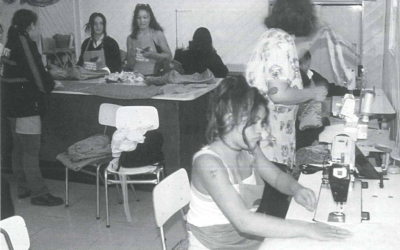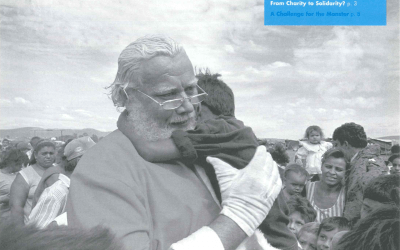Soccer And Youth Leadership In Peru
It ‘s Sunday at 2 p.m. in Lima, Peru. My friends and I meet to go to the stadium, as we always do on weekends. Nobody has watches or wallets, only the white and blue striped t-shirts we have worn since we were kids. We decide to take one car to avoid being trapped by the heavy traffic, the barras bravas (violent fans), and the human sea that converges from different districts of the city on to the stadium. Taking a short cut, we suddenly face exactly what we feared: a crowd of ragged looking youths, jumping and singing fanatically, war paint on their faces and flags waving in the wind. They surround us in a threatening manner and rock the car as though trying to overturn it. We lower the windows and despairingly show them the team colors on our chests and begin to sing together, loud, ever louder, until little by little they move aside, forming a corridor of bodies and songs that we urgently pass through. The mounted police arrived late but nevertheless violently crush the young crowd. We arrive on time to the stadium, but in the streets the game had already begun.
It’s rather ironic that soccer is often linked to violence in Latin America (and other places where it’s a sport of the multitudes) because soccer itself is a fairly non-violent sport, in which the basic rules of democracy and fair play are applied more often than in real life. Individuals of all social classes and ethnic groups, organized in two opposing teams, meet each other in equality of conditions, in public spaces built for this purpose, where the authority of the referees and the rules of the game are clear and widely respected. Furthermore, soccer clubs in Latin America are generally longstanding civic associations that are a fundamental part of civil society, linked to the history of a specific city, barrio or ethnic or social group. A precursor of the most modern idea of philanthropy, it creates solidarity between individuals of different social classes organized around a given club.
Nonetheless, the attraction towards soccer frequently results in street fights between followers of rival clubs, as well as fan violence and harassment within the stadiums themselves. The failures of democratization and the histories of political violence and social exclusion often add additional fire to the passions of the fans. In societies with strong social divisions, the followers of rival clubs (called barras bravas in Latin America, hooligans in Europe) build their own identity on the troubled histories and identities of their beloved teams. In Peru, these fans are largely poor urban youths organized in rival gangs, who head to the stadiums to “do battle” in an effort to “change their destiny” and obtain victories. The “enemies” are both the contenders and authorities who are always perceived as powerful and corrupt. In this sense, the passion for soccer has a contradictory outcome. On one hand, it encourages integration and solidarity between individuals of different social classes organized around a given club. On the other, it is one of the most important mechanisms of social differentiation in Latin American societies, reinforcing societal divisions and historical fault lines. Furthermore, the violent and undemocratic practices of soccer fans can affect many beyond their members and can come to threaten civic coexistence itself.
This recognition of the contradictory nature and potential of soccer fanaticism drove me and a group of fellow Sunday stadium-goers–mostly professors and students from the Catholic University of Peru–to develop a project called “Soccer and Barrios: Youth as Promoters of Local Development” (Futbol y Barrios: Jovenes Gestores de Desarollo Local). Launched in October 2000, with support from the AVINA Foundation, this unique initiative combines corporate philanthropy with student and professional volunteerism. The project seeks to channel the energy and passion of young soccer fans in more productive directions, converting the barra leaders into instruments for the development of their own communities. Through various forms of civic and vocational education and social interaction, the program’s aim is to undermine the violent and anti-democratic culture of these fans, while at the same time encouraging their enormous capacity for mobilization and leadership.
To help achieve these goals, we called on volunteer professionals in such areas as technical and vocational training, civic education, communications and psychology. Equally important, we harnessed the energies of another subset of Peruvian youths–middle and upper class student volunteers–who participate alongside their streetwise peers in various forms of training and development. For the barra leaders, some of whom already have criminal records longer than their job records, this project offers educational resources and civic experience that can increase their self-worth and future prospects, as well as increasing the social capital of the communities in which they live. The resources of this project go beyond the important financial contribution of AVINA (a Swiss-based corporate foundation) and other private donors. They bring together players who are normally detached from each other, but who share the same objective of ending violence in soccer: students, professors, volunteer professionals, civic and religious leaders, and the barra youths themselves.
In Peru as in many countries, some violence has always been associated with organized sports. However, this phenomenon emerged as a major social problem in the early 1990s, after the defeat of the Shining Path guerillas by the Armed Forces and national police. The political violence that shook the country during the prior decade left more than 30,000 people dead or disappeared and exacerbated deep social wounds. The regime that emerged to deal with it, under Alberto Fujimori’s authoritarian rule, also applied radical economic adjustment measures that drastically changed the labor market and rolled back many social functions of the State. These factors had a negative impact on the youths who came of age in the 1990s, kids who faced violence all around them and few prospects for a viable personal future. During these years, there were significant changes in the composition, forms of organization and collective behavior of the soccer barras. Historically, “crazed” soccer fans in Peru, as in Argentina and elsewhere, have been middle aged, often middle class men. However, the barras that emerged in Peru in the early 1990s–the so-called barras bravas–involved primarily poor urban kids. Over the last decade, these organizations have become spaces for building strong identities among such youth, as well as for reinforcing their aggressive and masculine styles.
Based on studies for UNICEF and the Catholic University, we found that the majority of these youths are secondary school dropouts, with early experiences of family violence and few marketable job skills. Some deal and use drugs, while others seek out temporary employment in the informal sector to survive from day to day. The media has generally sensationalized these characteristics and transforming these kids into feared social actors condemned by public opinion and undeserving of any kind of social assistance. This social exclusion reinforces not only their distrust of the authorities and public institutions, but also their sense of belonging to the barra, a form of organization that few outsiders know anything about. These barras operate as a community that allows members to cease being anonymous, gives them shared goals, and provides them with a sense of order in their lives, establishing firm routines and commitments, factors that are unusual in their normally de-structured lives.
Today, the soccer barras are well-organized networks that extend throughout the poor barrios of Lima and other major cities. The mission of the barra is to unceasingly cheer its soccer team on, following it in an almost religious pilgrimage through all the stadiums of the country, pressing the players to gain victories, watching over the conduct of the referees or authorities, and defending their flags and colors against the opposing barristas. To do this, the barristas manage collective funds, attend coordination meetings, settle internal disputes, plan fundraising activities, and distribute various resources among their members, such as free tickets to the stadium and team paraphernalia. Barras even provide economic support for members who are wounded in fights or jailed because of their activities in the group. Their leaders are also well known in other civil society organizations in the neighborhoods where they are based, and they coordinate with neighborhood boards, soup kitchens and local sports clubs. These activities make the barristas social actors with an enormous development potential.
To tap this potential, the Futbol y Barrios project proposed to work with 120 barra leaders over a two-year period. Participants were selected on the basis of the leadership potential they display in their neighborhoods, and their willingness to commit themselves to a number of training activities. Their engagement has been possible because of the mutual trust developed between the barristas and the university students involved in the project, a trust that was built up during two years of prior fieldwork I supervised as part of a research Workshop on Youth, Sports and Violence at the Department of Social Sciences of the Catholic University.
The Futbol y Barrios project is organized around four simultaneous lines of action. The first is to learn a trade or technical occupation that will allow the youths to be in better condition to join the labor market. After an evaluation of their occupational skills, the young men receive scholarships to prestigious technical training institutes, and special trainers who will help them learn a trade. The trainers, in turn, have been sensitized to the need to take a bet on these unconventional students.
The second line of activity is a civic training workshop that seeks to make the youths conscious of their natural leadership skills, but also of their rights and obligations as citizens. They are also given training in techniques for the settlement of disputes and criteria for community organization. The workshop begins by self-analysis of their own life experiences, and breaking down parts of that experience into different subjects that serve as modules. For example, one recurrent subject is police abuse on the way to the stadium. Professionals from NGOs specializing in rights and democracy guided discussion of this issue, seeking to teach them citizenship rights and to underscore how mistaken it is to respond to police violence with more violence of their own.
The third area is communications training to help these youths have a voice of their own that can be heard by society. The barrista intensively use graffiti and paint murals on the streets of their barrios and near the stadiums. They also produce their own designs or iconography that they stamp onto t-shirts and banners. Some barras even design their own Web pages and produce cassettes with songs and testimony to self-finance themselves. The communications program encourages these expressions, offering new and better techniques and seeking to influence the content and messages they convey. The barristas are also preparing to host a radio program to offer their opinions on subjects of youth interest and share information on their activities. In this way, youths who have been stigmatized as unredeemable have the opportunity to directly express themselves.
Finally, the fourth line of action involves local community development, in which the barristas propose initiatives that benefit their barrios. Volunteer university students help them translate these ideas into actions. These initiatives include frank talks on sexually transmitted diseases, art workshops for street children, cleaning and physical improvement of their barrios and paper recycling activities to help support themselves. These activities are one of the few spaces for encounters between youths who share the same generation, the same passion for sports, and similar vocations for social service, but whose educational and life experiences are radically distinct. In this encounter between student volunteers and barristas, we seek to reduce the vast social distance and distrust that marks Peruvian society, strengthening in a modest way the idea of citizenship, as well as promoting a fruitful exchange of knowledge.
Although this project was based on prior research (and fanatical participation) in the soccer world, it is still in the initial stages; we consider it a promise rather than a final solution. What we have observed so far, however, is encouraging. First of all, the participants have demonstrated a gradual decline in their drug consumption, as well as in their participation in street fights and violent conflicts. In most cases, they have also ceased to be seen as a risk to their neighbors and are gaining new respect in the community. Furthermore, the project has generated some healthy new forms of competition among the rival barras. For example, the “Comando SVR” gang, associated with the Alianza Lima club, has developed its own project entitled “Barrios Blanquiazules” (white and blue barrios, the official team colors), which combines the establishment of soup kitchens to fight malnutrition with anti-drug campaigns. Their leaders have submitted this project to a government agency and to potential private donors. Meanwhile, their traditional rivals, the “Trinchera Norte” group associated with the Universitario club, has started its own project on “participatory citizenship” (ciudadania participativa), with the support of a consortia of private universities, in the crime-ridden neighborhood of El Agustino. This effort is run by the leaders of “Locura,” the local branch of the barra and a youth gang that until now has been largely known for its highly antisocial behavior. Additionally, the “Extremo Celeste” group associated with the Sporting Cristal club has requested support from the Backus Corporation, which owns the club, to sponsor an occupational training program for their members.
While these programs alone may not eliminate youth violence in a society as troubled as Peru, we believe they are a step in the right direction–or to put it in sporting terms, un golazo de media cancha.
Spring 2002, Volume I, Number 3
Aldo Panfichi, currently a Visiting Scholar at DRCLAS, is a professor of Sociology at Catholic University of Peru. He is an honorary AVINA civic leader, and member of the Board of Alianza Lima soccer club.
Related Articles
Obras de Infraestructura Básica de Fácil Ejecución a través de la Autogestión
En el Ecuador rural y en las zonas citadinas marginales, la carencia de servicios básicos se ha convertido en un mal endémico no resuelto hasta …
Responsabilidad Social Empresarial: Algunos Hechos Que Cuentan
La Responsabilidad Social Corporativa (RSC) es una temática más bien nueva en Chile. Aún cuando se encuentran acciones filantrópicas desde tiempos de la colonia, la relación de la …
Algunos Casos en Chile
Un caso fue José Tomás Urmeneta, un empresario del siglo XIX quien, en un momento de auge del sector agroexportador chileno, en su testamento dejó asignados recursos para …




